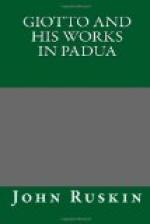Giotto continues to exert all his strength on these closing subjects. None of the Byzantine or earlier Italian painters ventured to introduce the entire figure of Christ in this scene: they showed the feet only, concealing the body; according to the text, “a cloud received Him out of their sight.” This composition, graceful as it is daring, conveys the idea of ascending motion more forcibly than any that I remember by other than Venetian painters. Much of its power depends on the continuity of line obtained by the half-floating figures of the two warning angels.
I cannot understand why this subject was so seldom treated by religious painters: for the harmony of Christian creed depends as much upon it as on the Resurrection itself; while the circumstances of the Ascension, in their brightness, promise, miraculousness, and direct appeal to all the assembled Apostles, seem more fitted to attract the joyful contemplation of all who received the faith. How morbid, and how deeply to be mourned, was the temper of the Church which could not be satisfied without perpetual representation of the tortures of Christ; but rarely dwelt on His triumph! How more than strange the concessions to this feebleness by its greatest teachers; such as that of Titian, who, though he paints the Assumption of the Madonna rather than a Pieta, paints the Scourging and the Entombment of Christ, with his best power,—but never the Ascension!
* * * * *
XXXVIII.
THE DESCENT OF THE HOLY SPIRIT.
This last subject of the series, the quietest and least interesting in treatment, yet illustrates sadly, and forcibly, the vital difference between ancient and modern art.
The worst characters of modern work result from its constant appeal to our desire of change, and pathetic excitement; while the best features of the elder art appealed to love of contemplation. It would appear to be the object of the truest artists to give permanence to images such as we should always desire to behold, and might behold without agitation; while the inferior branches of design are concerned with the acuter passions which depend on the turn of a narrative, or the course of an emotion. Where it is possible to unite these two sources of pleasure, and, as in the Assumption of Titian, an action of absorbing interest is united with perfect and perpetual elements of beauty, the highest point of conception would appear to have been touched: but in the degree in which the interest of action supersedes beauty of form and colour, the art is lowered; and where real deformity enters, in any other degree than as a momentary shadow or opposing force, the art is illegitimate. Such art can exist only by accident, when a nation has forgotten or betrayed the eternal purposes of its genius, and gives birth to painters whom it cannot teach, and to teachers whom it will not hear. The best talents of all our English painters have been spent either in endeavours to find room for the expression of feelings which no master guided to a worthy end, or to obtain the attention of a public whose mind was dead to natural beauty, by sharpness of satire, or variety of dramatic circumstance.




